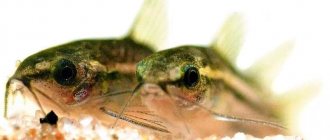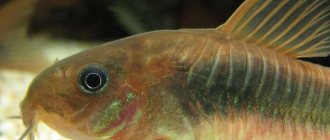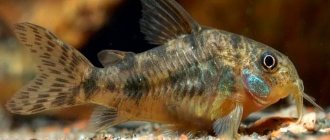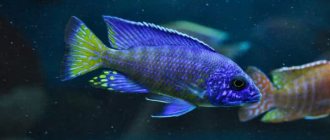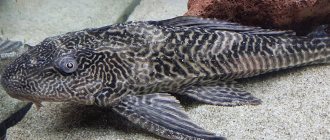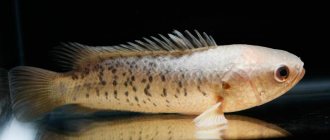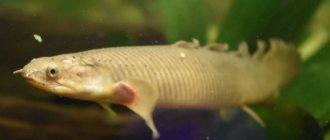04/20/2019Pisces0
Corydoras Julie is an active and peaceful pet, interesting to watch and useful as a bottom cleaner. The compact catfish with its distinctive leopard-like coloration and high “shark” fin is attractive to beginners and experienced aquarists.
- 1 Description and habitat
- 2 Mr. Tail Recommends: Basics of Aquarium Keeping
- 3 Compatibility
- 4 Feeding
- 5 Breeding
Habitat in nature
Its habitat is Northeastern Brazil. Native to coastal river systems south of the Amazon delta in the states of Piauí, Maranhão, Pará and Amapa.
It has been found in the Guama River (including tributaries such as the Rio Ararandeua), Maracana, Morsego, Parnaiba, Piria, Caete, Turiazu and Mearim. Found in small rivers, tributaries, forest streams and other bodies of water in the jungle.
It received its name in honor of a person whose identity remains unknown.
Corydoras Julie is often confused with leopard corydoras or trilineatus because these fish are very similar in appearance to another species of corydoras - Corydoras trilineatus. This species lives in the upper reaches of the Amazon and is less whimsical.
The prevalence and demand for these fish has led to the fact that even sellers often cannot confidently say what they are selling. However, it is possible to distinguish them.
C. julii has one distinct stripe on its side, while C. trilineatus has several and are much more pronounced. There are still differences, but only a specialist can see them.
Corydoras Julie catfish: maintenance, breeding, photo-video review
Corydoras Julie, Corydoras Julia, Corydoras Julia or Leopard Corydoras - all these are names of the same aquarium fish - Corydoras julii.
Like other representatives of this genus, it belongs to the family of callichtid (armored) catfish, which means it prefers bottom layers in the aquarium. This species is found naturally in South America, in the reservoirs of eastern Brazil.
Due to its similar color, it is often confused with its two relatives - Corydoras sterbai and Corydoras trilineatus.
- Julie has very small black dots on a light gray or cream background of her head;
- Shterb has many light dots on his dark gray, almost black muzzle;
- Trilineatus has thin black lines on its light body, for which it is sometimes also called trilineatus. Sometimes the three-lined Corydoras is passed off as Julie, since the latter are extremely rare on sale.
Adult fish reach a maximum of 5-6cm. It is difficult to distinguish a male from a female - females are slightly larger and wider. They live in an aquarium for about 5 years.
Description
Julie is one of the most noticeable Corydoras due to its contrasting coloration. The body is white-gray, close to the color of ivory, and small black dots and wavy lines are scattered on it. Along the lateral line there are merging points, forming a black line extending to the tail. There is a black spot at the tip of the dorsal fin, and vertical black stripes on the caudal fin.
There are no dots on the abdomen, it is light. There are three pairs of whiskers near the mouth.
The fish grows up to 7 cm in size, but usually smaller, about 5 cm. Life expectancy is 5-10 years, depending on the conditions of detention.
Reproduction and breeding of corydoras
Breeding corydoras is a simple process and is accessible even to novice aquarists. It will require a spawning aquarium. But first things first.
Selection of manufacturers
The first stage is the selection of manufacturers. Catfish are ready to breed at about 8 months.
Poor parents should be carefully selected, since they exhibit weak sexual dimorphism. If you look closely, the female can be identified by its richer color, rounded short dorsal fin and larger size (males are slightly smaller in size).
Before boarding the fish for spawning, it is necessary to start feeding them with high-protein food 2 weeks in advance. For breeding, one female and 2-3 males are usually chosen.
Preparing a spawning aquarium
An aquarium with a volume of about 15 liters will be enough, depending on the number of fish. No special arrangement is required inside.
There is no need to use soil in the spawning tank, but plants with large leaves (live or artificial) will not be damaged. It could be Anubias, for example. You should also put a flat stone or grotto, which will serve as an additional substrate for the eggs.
To stimulate spawning, it is necessary to create suitable conditions.
- Daily water changes in the spawning tank, in small portions, with fresh, preferably soft (osmotic) water. Second, the temperature of the fresh water should be several degrees lower than that in the spawning aquarium. The temperature drop should be stopped when it reaches 21-23°C.
- Enhanced aeration.
- Adding live food (aulophorus or tubifex) to the producers, this further encourages the fish to spawn.
Spawning process
The resettlement of producers is carried out in the evening. The spawning process itself occurs in the morning or during the day. Sometimes you have to wait several days for the start of spawning.
The whole process looks quite unusual. The males begin to chase the female throughout the aquarium. She lays eggs in the folded pelvic fins, and collects milk from the male in her mouth.
Then she selects a suitable place on glass, plant leaves or decorations, smears it with milk and attaches the eggs to them. This process is repeated several times.
During one spawning, one female lays about 200 eggs. Upon completion of spawning, the spawners can be returned to the general aquarium, as the fish do not have an expressed instinct to care for their offspring.
Caring for fry
It usually takes 5-6 days for the eggs to develop and the larva to appear. This is a fairly long period of time during which a large percentage of eggs can be affected by the fungus.
To minimize losses and speed up the development process, it is enough to raise the temperature in the spawning aquarium to 27-28°C and add a few drops of methylene blue to the aquarium. Within 3 days, larvae will emerge from the eggs. After their appearance, the temperature should be gradually returned to the optimal 22-25°C.
Keeping in an aquarium
Like most corydoras, Julie's catfish is peaceful and fits perfectly into most community aquariums. However, it also needs to be kept only in a school, and the larger this school is, the more comfortable the fish will be and the more natural their behavior will be.
The recommended minimum quantity is 6-8 individuals.
One of the key requirements for comfortable maintenance is a non-abrasive substrate made of sand and fine gravel. In nature, catfish constantly dig in the ground, looking for insects and their larvae. They use their sensitive antennae to search, and if the ground is large or sharp, these antennae will be injured.
Fine and medium sand will be an ideal soil, but fine gravel or basalt will also work. Although plants are not necessary for comfortable maintenance, their presence gives the aquarium a natural look and creates shelter for catfish.
However, you can and should use driftwood and fallen tree leaves along with the plants. It is in these conditions that Julie's corydoras live in nature.
They love moderate currents and clean water. It is better to use an external filter, but internal ones are also suitable for small volumes.
Optimal water parameters: 22–26 °C, dGH 2–25°, pH 6.0–8.0.
Maintenance and care
Conditions
The basic rules for keeping Julie are not much different from other types of corydoras. This catfish also needs a flock, preferably from 6 individuals. The volume of the aquarium is from 5 liters per fish, for a couple – a 20 liter is suitable, for a group – at least 50 liters.
Water parameters are similar to those required for most corydoras: hardness 2-25°dH (soft is preferred, fish will have to adapt to hard water), acidity - 6-8pH, temperature 22-26°C (higher than for speckled, but slightly lower than needed for Shterb). Naturally, weekly water changes are required - 20-30% of the total volume.
For catfish of this species, the presence of a filter is a very important factor; in addition, additional aeration of the water will be a big plus (all corydoras can swallow air from the surface, but the higher the degree of oxygen dissolved in the water, the better your pets will feel).
Catfish, as a rule, are nocturnal fish and prefer to be in shelter during the day, so the more grottoes, pipes and other places in which they can hide in their aquarium, the better. For soil, it is recommended to use sand (as coarse as possible so as not to caking) or medium, small-sized rounded pebbles. The presence of a certain number of plants will also be a plus. As for lighting, it should be moderate and diffused; Julie, like his relatives, does not like too bright light.
Feeding
Julie's corydoras catfish can eat any type of food. These fish are very fond of live food - tubifex, worms, brine shrimp, cyclops. You can also use special food for bottom fish species, these are granules and tablets that sink, so that catfish do not need to rise to the surface for food. By the way, Julie's corydoras extremely rarely float to the upper layers of the aquarium, therefore, regardless of the type of feeding chosen, food must fall to the bottom, otherwise the fish risk remaining hungry.
Compatibility with other fish
All aquarium corydoras catfish are peaceful creatures that can get along with most calm and peace-loving fish species. And Corydoras Julie is also one of them, the main thing is that the size of the neighbors does not exceed the size of the catfish too much, otherwise it may become the object of hunting as a possible food.
Aggressive fish, predators and, importantly, those types of bottom fish that, due to their territoriality, can pester small corydoras with their attacks should be excluded from the aquarium (in this case, a very large area of the aquarium bottom can help the fish not intersect).
Feeding
All corydoras are omnivorous, feeding on the bottom. In most cases, sinking food (especially intended for catfish), live and frozen food (they like tubifex), and vegetable tablets are excellent.
Feeding a variety of types of food is the key to healthy and large fish. In no case should you rely on the fact that Julie's corydoras are scavengers and will live on what other fish have not found.
These fish need proper feeding; you need to make sure that they get enough food, especially if you have a lot of fish living in the middle layers of water.
Corridors Julie
Corydoras Julie
Order, family: armored catfish.
Comfortable water temperature: 24-26° C. Acidity: 6.5-7.5 Hardness: 5-15.
Aggressiveness: non-aggressive.
Compatibility: any fish. Only overtly aggressive fish are not desirable.
Description: Corydoras julie lives in South America.
Corydoras juli has a small body with a convex back, covered with a shell, which consists of two rows of bone plates located on the sides of the body. These catfish are easy to keep in an aquarium. It is advisable to use sand as a soil. It is necessary to have a large number of shelters in the form of stones, snags or grottoes where fish can hide and rest.
Water parameters: temperature 24-26° C, dGH 5-15°, pH 6.0-7.0. Water filtration is required and weekly replacement of 1/5 of the total volume of the aquarium is advisable. Fish are undemanding to the quality of aeration.
Corydoras, in addition to gill respiration, also have intestinal respiration, so it is desirable that the surface of the water be free of plants so that the fish can freely swallow fresh air.
Pisces are very peaceful and calm. They slowly swim along the bottom in search of food. In an aquarium they are usually kept in a flock. The fish do not pose any threat to other inhabitants of the aquarium.
Julie catfish video
Feeding aquarium fish should be correct: balanced, varied. This fundamental rule is the key to the successful keeping of any fish, be it guppies or astronotuses. The article “How and how much to feed aquarium fish” talks about this in detail; it outlines the basic principles of the diet and feeding regime of the fish.
In this article, we note the most important thing - feeding fish should not be monotonous; the diet should include both dry food and live food. In addition, you need to take into account the gastronomic preferences of a particular fish and, depending on this, include in its diet food either with the highest protein content or, conversely, with plant ingredients.
Compatibility
Perfectly compatible with most small catfish and other fish. It is possible to keep with zebrafish, rasboras, dwarf Ramirezis, even angelfish. Only large and aggressive fish should be avoided.
The most common types
In amateur aquarium keeping, the following types of corydoras catfish are most often found:
Speckled catfish
The most widespread representative of Corydoras is the speckled one. Unpretentious, beautiful, active and hardworking - in short, everything an aquarist needs! It is these qualities that made the speckled corydoras one of the most popular aquarium catfish.
Adolf
A small, very cute catfish with a bright orange cap on its head and a well-defined black stripe on its back. The body length does not exceed 5 cm. In an aquarium, Corydoras Adolfa practically does not reproduce.
Arquatus
Also known as two-lane. In natural conditions it lives in Brazil and Peru. The size of the arcuatus is no more than 5 cm. The main body color is golden. A wide black stripe runs along the ridge.
Julie (leopard)
A very beautiful and interesting catfish comes from Brazil. The main body color is silver-gray with dark spots forming patterns. The abdomen is uniform, light. The top of the dorsal fin is black. Julie's corridor is also known as leopard print.
Duplicareus
A distinctive feature of the species is a pronounced black stripe running through the eyes and the top of the back. It occurs naturally in Colombia, mainly in the Meta River. The body length of Duplicareus does not exceed 5 cm. The name translated from Latin literally means “one more”. Thus, scientists wanted to emphasize the similarity with Adolfi.
Golden albino
A very interesting albino catfish. The main body color is white-pink, the eyes are bright yellow with a well-defined red pupil. Natural habitat: South America and Brazil.
Nanus
The body is silvery with a characteristic black pattern. The forehead and part of the back are green or olive. The pattern on the sides forms three stripes. In nature, Corydoras Nanus is found in the eastern part of Brazil.
Trilineatus
A species very similar to Corydoras Julie. It differs only in the shape of the fins. In nature, trilineatus is found in Brazil and Peru. In the aquarium it occupies the lower, bottom level. Conditions of detention are the same as for all corridors.
Khabrosus
Miniature in appearance, the average size of the fish does not exceed 3 cm. Corydoras habrosus attracts with its striking coloring of chaotically located black spots. It is advisable to keep this species in a flock of 6 or more individuals.
Hastatus
A miniature catfish no larger than 2.5 cm in size. Hastatus is also known as the dwarf or sparrow. Very easy to keep, peaceful in appearance. It feels best in a flock of 10-15 individuals.
Shterba
A type of corydoras measuring no more than 5 cm. Thanks to the chaotic dot pattern, it looks very unusual and decorative. Shterba is recommended for school keeping. Angelfish, tetras and other small fish of a peaceful disposition can be used as neighbors.
Golden (bronze) corridor
Golden catfish have arrived from Venezuela and Trinidad to our aquariums. The color of representatives of this subspecies can range from gray-golden to rich bronze. In an aquarium, the fish grows up to 7 cm.
Panda
The resemblance of this catfish to the Asian bear is obvious. The birthplace of this species is the Ucayali River in Peru. Grows no more than 5 cm in an aquarium
It is very important for pandas that the water temperature in the aquarium does not fall below 17 degrees
Reviews
Aquarists speak positively about Corydoras. Although the timidity of catfish seems like a drawback for some.
Choosing the right healthy catfish in the store
Catfish have strong immunity. They are able to withstand temperature changes.
When purchasing fish, pay attention to the behavior of the selected representative of the fish world:
- You should not take fish lying on the bottom and not paying attention to external stimuli;
- Look how representatives of the water element breathe. Fish breathing should not be heavy, but the absorption of air should be lightning fast, after which the fish actively begins to decline. If a fish suffers from an illness, then it is constrained in its movements, and seems to fly to the bottom like a stone.
- Watch the fish swim. If at the same time it itches, the movement is jerky, there are problems with coordination balance and spatial orientation, then leave such a fish in the store;
- Attractive spots and large growths indicate a destructive fungus. Reddish spots on the abdomen indicate a hidden bacterial infection.
- Be sure to check the integrity of the mustache; it is better to discard damaged ones.
- The fins are intact, straightened, without traces of destructive fin rot. If they are stuck together or have pronounced red stripes, take a closer look at another shell;
- The eyes of a healthy fish are clean, not covered with film or cloudiness, not bulging or sunken.
- Avoid catfish with visually inflamed or mucus-covered respiratory gills. It is dangerous if they are too dark - this is a sign of nitrogen intoxication.
- You should not buy shellfish with a thin, sunken or convex abdomen. The first indicates the presence of pathogenic microorganisms or complete depletion. And the second may be a signal of many hidden illnesses that end in death.
- And lastly, buy fish of different sizes, and not just the most massive ones.
It is better to take active fish
When choosing a suitable specimen, pay attention to the following signs of sickness in catfish:
- Sticky fins;
- Cloudiness of the eyes, film coating;
- Damaged mustache;
- Inflammation or redness on the gills.
Red-brown spots are a sign of the development of a pathogenic fungus in the fish’s body. A sunken abdomen indicates exhaustion and helminth infestation.
Corydoras catfish are schooling, unpretentious, cheerful fish. If you follow the general rules of care, they will live and delight you with their beautiful appearance for 15 years. Follow the prescribed valuable recommendations, carefully select shellfish before purchasing, quarantine newcomers, all these actions will help you avoid major mistakes in keeping peace-loving catfish.
Popular decorative echinodorus: content features
Water. Such plants are usually kept in deep aquariums, since the height of the bush can reach 60 cm or more. Grass is planted, as a rule, in the center of the aquarium space closer to the back wall, and from the point of view of composition, the bush represents the center of the underwater interior.
It is advisable to use coarse sand or fine gravel as a substrate for the soil, and it will be better if you add natural river silt to the soil.
The optimal temperature is considered to be from +18 to +26 degrees, and water hardness should be in the range of 6-10 degrees. The pH balance should be maintained close to neutral.
All these are general conditions for most decorative echinodorus, but there are also characteristics for each species.
What diseases are they susceptible to?
The unassuming Corydoras fish has a strong immune system. This inhabitant of the aquarium world has no specific diseases. They are able to withstand minor fluctuations in the aquatic environment. For preventive purposes, it is not advisable to use kitchen or sea salt.
These fish have strong immunity
Fungus
The presence of a problem is determined by growths on the fins, spots or cotton wool on the body. To cure the fish of illness, baths are arranged in a separate container. Potassium permanganate is suitable as a disinfectant; the catfish is kept in it for about 5 minutes. If furacillin is used as a basis, then it is dissolved in proportions of 1 g per 10 liters of water. The duration of this bath is 30 minutes. It is strictly forbidden to use saline solution; catfish cannot tolerate this composition and die from it.
Fungus in fish appears on the body or fins
Poisoning with nitrogen compounds
Corydoras fish suffer from their own toxins, which can easily cause poisoning. In the natural environment they hide from toxic waste, but in a confined aquarium this is almost impossible to do. Signs of an increase in the level of nitrogen compounds in water are bubbles on the surface of the water. The only way out of this situation is to place the corridor in a tank with purified water.
Poisoning in fish occurs due to their own toxins
